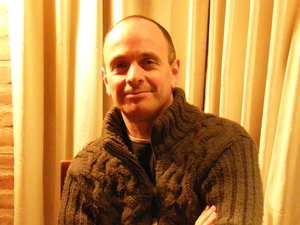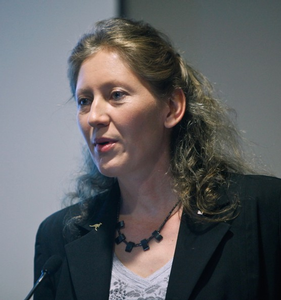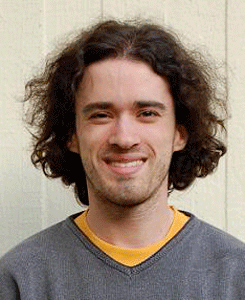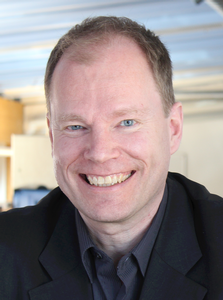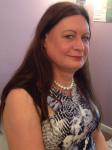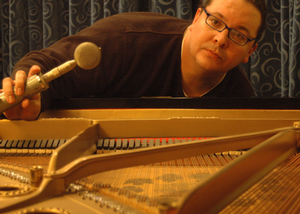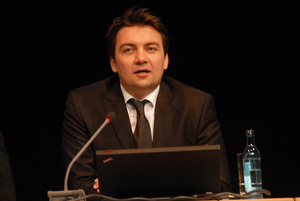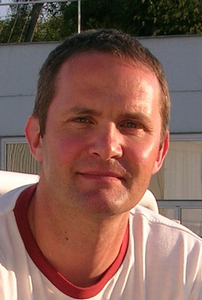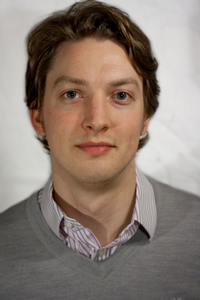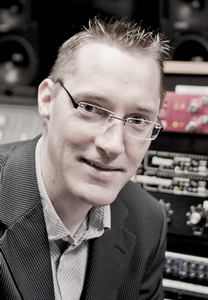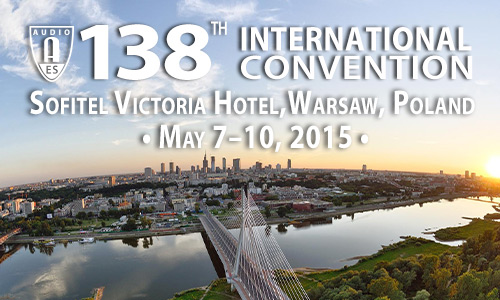
AES Warsaw 2015
Tutorial Details
Thursday, May 7, 11:15 — 12:45 (Room: Królewski)
T1 - Music Information Research from a Cultural Perspective
Presenter:Xavier Serra, Universitat Pompeu Fabra - Barcelona, Spain
Abstract:
A major challenge in Music Information Research (MIR) is the automatic generation of musically meaningful information with which to better describe and exploit audio music recordings. But a piece of music makes sense especially within a particular social and cultural context and its analysis and description has to take that into account. In this tutorial I will introduce the research being done in the project CompMusic (http://compmusic.upf.edu) related to the extraction of musically relevant features from audio music recordings related to melody and rhythm, and on the semantic analysis of the contextual information of those recordings, by studying five world music traditions that have a quite distinct personality: Hindustani (North India), Carnatic (South India), Turkish-makam (Turkey), Arab-Andalusian (Maghreb), and Beijing Opera (China).
Thursday, May 7, 14:30 — 16:00 (Room: Królewski)
T2 - Audio Forensics—What's it All About
Chair:Eddy B. Brixen, EBB-consult - Smorum, Denmark
Panelist:
Gordon Reid, CEDAR Audio Ltd - Cambridge, UK
Abstract:
Working with audio forensics is serious business. Depending on the work of the forensics engineer, people may eventually end up in prison. This tutorial will present the kind of work related to the field. This covers fields as acoustics, when audio analysis can be a part of the crime scene investigation. Voice acoustics: Who was speaking? Electro acoustics: Checking data on tapes, discs or other data storage media. Recording techniques: Is this recording an original production or is it a copy of others' work. Even building acoustics and psychoacoustics, when the question is raised: Who could hear what? However, the most important "everyday work" of the audio forensics engineers is cleaning of audio recordings and providing transcriptions. In this tutorial state-of-the-art sound cleaning will be demonstrated.
Thursday, May 7, 14:30 — 16:00 (Room: Opera)
T3 - Foundations and Practical Aspects of Sound Field Synthesis
Presenters:Sascha Spors, University of Rostock - Rostock, Germany
Franz Zotter, IEM, University of Music and Performing Arts - Graz, Austria
Abstract:
Sound Field Synthesis (SFS) aims at the physical synthesis of sound fields within a predefined listening area by an ensemble of loudspeakers. Wave Field Synthesis (WFS) and higher-order Ambisonics (HOA) are two prominent representatives of Sound Field Synthesis. This tutorial outlines the history of SFS, its acoustic foundations, and discusses how practical solutions can be achieved in terms of loudspeaker arrays and digital signal processing. The practical realization by such systems involves various approximations and limitations. The technical and psychoacoustic impact of these is reviewed. This tutorial concludes with an outlook on recent research results and developments.
Thursday, May 7, 14:30 — 15:45 (Room: Balowa)
T4 - Mastering for Musicians and Home Studio Owners
Presenter:Andres A. Mayo, Andres Mayo Mastering & Audio Post - Buenos Aires, Argentina
Abstract:
With technology becoming cheaper and easier to use than ever, most artists are willing to create at least a part of their records at home. This event shows the difficulties that will appear and how to handle them in the most efficient way, taken from real-life examples at the mastering studio. With over 25 years in the mastering field, Mayo has first-hand experience in the dramatic changes of the recording process. This workshop aims to show what you should know before giving the final touch to a mix.
Thursday, May 7, 16:30 — 18:00 (Room: Królewski)
T5 - Digital Transfer of the Armando Leça Folk Music Collection
Presenter:Nadja Wallaszkovits, Phonogrammarchiv, Austrian Academy of Science - Vienna, Austria
Abstract:
Nadja Wallaszkovits will discuss the restoration, transfer, and digitization of a unique collection of folk music recorded during 1939–1940 in the rural areas and mountain villages of Portugal by the folklorist Armando Leça, in collaboration with National Radio (Emissora Nacional). Her presentation will open with a short introduction of this important field research project that resulted in the first known collection of recordings documenting rural musical practices from nearly all regions of Portugal. Thereafter, she will present a historical overview of early magnetic tape developments and the birth of audio tape recorder technology, focusing on the characteristics of the individual tape machine used by Armando Leça. The problems of carrier handling, restoration, and transfer of these valuable original tapes will be discussed along with the judicial use of signal enhancement during the playback process.
Friday, May 8, 11:15 — 13:15 (Room: Belweder)
T6 - Microphones—Can You Hear the Specs?
Chair:Eddy B. Brixen, EBB-consult - Smorum, Denmark
Panelists:
Jürgen Breitlow, Georg Neumann GmbH - Berlin, Germany
David Josephson, Josephson Engineering, Inc. - Santa Cruz, CA, USA
Helmut Wittek, SCHOEPS GmbH - Karlsruhe, Germany
Abstract:
There are lots and lots of microphones available to the audio engineer. The final choice is often made on the basis of experience or perhaps just habits. (Sometimes the mic is chosen because of the looks...). Nevertheless, there is good information to be found in the microphone specifications. This tutorial will present the most important microphone specs and provide the attendee with up-to-date information on how these specs are obtained and understood and how it relates to perceived sound. It takes a critical look on how specs are presented to the user, what to look for, and what to expect.
Friday, May 8, 11:45 — 13:15 (Room: Królewski)
T7 - Live Sound Subwoofer System Calibration
Presenter:Adam J. Hill, University of Derby - Derby, Derbyshire, UK
Abstract:
Achieving even low-frequency coverage across a large audience area while simultaneously minimizing sound energy on stage is easier said than done in large-scale live sound reinforcement. Non-ideal subwoofer system calibration causes severe seat-to-seat variability in frequency response, which often goes unnoticed by engineers firmly planted to the mix position. This tutorial presents practical approaches to system calibration which provide improved low-frequency performance. Source placement, polar pattern control, clustering and DSP techniques are explained using simulations to highlight their respective advantages and disadvantages. All solutions offered consider practical restrictions including: system efficiency, stage layout, truck space, work timeframe, budget, etc. Perceptual considerations are also touched upon, inspecting whether the increasingly-common method of driving subwoofers with a mono auxiliary send is an imperfect approach.
Friday, May 8, 12:30 — 14:00 (Room: Opera)
T8 - Listening Tests—Understanding the Basic Concepts
Presenter:Jan Berg, Luleå University of Technology - Piteå, Sweden
Abstract:
Listening tests and other forms of data collection methods that rely on human responses are important tools for audio professionals as these methods assist our understanding of audio quality. There are numerous examples of tests, either formally recommended and widely used, or specially devised for a single occasion. In order to understand listening tests and related methods, and also to potentially design and fully benefit from their results, some basic knowledge is required. This tutorial aims to address audio professionals without prior knowledge of listening test design and evaluation. The fundamentals of what to ask for, how to do it, whom to engage as listeners, what sort of results that may be expected, and similar issues will be covered— preferably in co-operation with the audience. The goal is to create an understanding of the basic concepts used in experimental design in order to enable audio professionals to appreciate the feasibility of listening tests.
Friday, May 8, 14:15 — 15:45 (Room: Opera)
T9 - Interactive Music: Past, Present, and Future…
Presenters:Justin Paterson, London College of Music, University of West London - London, UK
Rob Toulson, Anglia Ruskin University - Cambridge, UK
Abstract:
Listeners have long been inspired to interact with commercial music and create new representations of popular releases. Vinyl offered many opportunities to reappropriate chart music, from scratching and tempo manipulation to mixing multiple songs. Nowadays, artists can engage their audience to interact with the music by offering mix stems for experimentation, a trend started by Nine Inch Nails in 2005 continuing to artists such as U2 in 2014. With the extended processing power of mobile devices, the opportunities for interactive music are limitless; both Bjork and Peter Gabriel have explored these new platforms in an interactive manner. In this session the presenters will offer a history and context of interactive music, demonstrate their own funded research activities, and discuss future possibilities.
Saturday, May 9, 09:00 — 11:00 (Room: Opera)
T10 - Modern Digital to Analogue Conversion: Audio Alchemy Using Signal Processing
Presenter:Jamie Angus, University of Salford - Salford, Greater Manchester, UK
Abstract:
Almost all modern digital to analogue convertors (DACs) use oversampled multibit convertors with noise-shaping to achieve their high performance. Oversampling and noise-shaping allow one to use a DAC with a small number of levels, which is easier to manufacture. Unfortunately traditional noise shaping does nothing to reduce the effect of component tolerances in the DAC because the analogue output cannot be fed back to the input. However, modern DACs do manage to noise shape the output from the DAC without any feedback. This piece of audio alchemy is critical to the exceptional performance of modern digital-to-analogue convertors. Using audio examples, this tutorial will explain how this alchemy is achieved. It will review the problems of component tolerance in DACs and show how they compromise performance. Then noise-shaping, and how it can be applied, without magic or knowing the actual converted output, to a practical DAC will be explained.
Saturday, May 9, 11:15 — 12:45 (Room: Opera)
T11 - Time Reversal in Sound Recordings
Presenter:Alex Case, University of Massachusetts Lowell - Lowell, MA, USA
Abstract:
A survey of the many moments in pop music in which sounds have been presented backwards—ending where they started, starting where they ended, and un-decaying in between—reveals a long history of reveling in recorded reversals. While such sounds can't happen in nature, they are a common studio creation, possessing strong musical value and delivering intriguing technical and perceptual advantages.
Saturday, May 9, 11:30 — 13:30 (Room: Balowa)
T12 - Main Microphone Techniques for 2.0, 5.1, and 3-D Audio
Presenter:Helmut Wittek, SCHOEPS GmbH - Karlsruhe, Germany
Abstract:
This tutorial will explain step-by-step, using many practical examples, what a suitable stereophonic microphone array can look like. With 2.0 stereo setups as the starting point, multichannel, and 3-D arrays will also be introduced.
Many factors influence the choice of a stereophonic microphone setup, but the relevance of these factors can vary greatly depending on the application, such that there is never one single “correct” setup. Knowledge of various options gives a Tonmeister the ability to make optimal choices.
With the participation of Mike Williams
Saturday, May 9, 12:15 — 13:45 (Room: Belweder)
T13 - Loudness 101 – LUFS Is in the Air
Presenter:Florian Camerer, ORF - Austrian TV - Vienna, Austria; EBU - European Broadcasting Union
Abstract:
This session will bring participants up to speed regarding the latest aspects of loudness control and metering. It is targeted to sound engineers in general, giving a brief intro to the algorithm and the metering paradigms and then expanding to common misunderstandings, dangers as well as chances and challenges. Some new concepts like "gating" and "true peak level" will be explained in detail. As chairman of the European loudness group PLOUD and senior post-pro mixing engineer at ORF (Austrian TV), Florian Camerer has enough experience under his belt to provide a thorough workout! Be ready to sweat!
Saturday, May 9, 17:00 — 18:00 (Room: Opera)
T14 - Object-Based Broadcasting—The Future of Broadcasting?
Presenter:Chris Baume, BBC Research and Development - London, UK; University of Surrey - Guildford, Surrey, UK
Abstract:
The audio research group at BBC R&D has for the past four years been developing the next generation of audio for broadcast. Working with academic partners in the BBC Audio Research Partnership, the group has created novel audience experiences based on new forms of audio content representations. This work has led to the launch of large-scale funded projects involving a significant number of researchers and international industrial partners. This talk will outline a number of public trials around object-based audio and binaural experiences which demonstrates the potential future of broadcast. The talk will focus on the audience experience, but will also detail the technological challenges from a content provider perspective.
Sunday, May 10, 09:15 — 10:15 (Room: Opera)
T15 - Mic It & Record It!
Presenter:Ian Corbett, Kansas City Kansas Community College - Kansas City, KS, USA; off-beat-open-hats recording & sound reinforcement
Abstract:
You should not start a recording project without knowing how you want the mix to sound, and how to record the sounds you need to create that mix. Learning to use microphones and mic techniques to capture sounds “in their place in the mix” will not only produce more spacious multi-dimensional mixes needing less electronic processing to achieve that goal, but also create a more efficient workflow that speeds up the mixing process. Come and learn how to approach the recording session from the perspective of the mix, how different microphone technologies can beneficially colour and shape the sounds you’re recording, how different instrument, vocal, and stereo mic techniques affect the sounds captured, and how the recording room’s affect on the sound source and the microphones can be exploited and explored to help you capture sounds you actually need for the mix. For students and professionals alike, understanding these techniques will increase the variety of mix styles and sounds you are able to produce, making you a more versatile audio engineer ready to meet the needs of clients and employers today and tomorrow.
Sunday, May 10, 11:30 — 13:30 (Room: Balowa)
T16 - [MC] Creating Music for Film and TV
Chair:Brian McCarty, Coral Sea Studios Pty. Ltd - Clifton Beach, QLD, Australia
Presenter:
Maciej Zielinski
Abstract:
The composition of music for film and television is a detailed process with its own challenges and special recording techniques. Here we present two of Poland's best.
